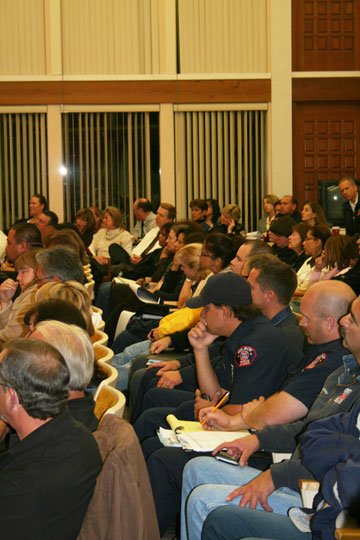Rather than rubber stamp the city administrator’s plan to layoff
16 percent of Gilroy’s workforce, the city council told him to
consider delaying more projects and employee raises, seeking
additional revenue and reducing hours in addition to personnel
cuts. Council members made it clear, though, that some layoffs are
all but certain.
Rather than rubber stamp the city administrator’s plan to layoff 16 percent of Gilroy’s workforce, the city council told him to consider delaying more projects and employee raises, seeking additional revenue and reducing hours in addition to personnel cuts. Council members made it clear, though, that some layoffs are all but certain.
Councilwoman Cat Tucker was the only one to vote against laying off employees, and she and Councilman Peter Arellano also voted against the Jan. 31 layoff deadline, but the two joined all their colleagues in separate votes to delay additional infrastructure projects and to cut another $1.5 million in expenses. Whether those cuts lead to more layoffs or less projects is still up in the air, but council members made it clear that somewhere around 44 people will lose their jobs, which will save the city $3.3 million this fiscal year and $6.7 next year.
“This is the beginning of this city’s resolve,” Mayor Al Pinheiro told the crowd of engineers, office assistants, firefighters, police officers, building inspectors and a host of other employees. “We were elected to protect the financial integrity of the city.”
But employees – nearly 200 of whom packed the council chambers and spilled out into the foyer with family members – said they have to look out for the integrity of their families, as well.
“For many of us our ship is sinking and it’s sinking quickly,” Housing and Community Development Technician Sandra Nava said. “We really need you to think about us, our families. There are single parents here, others’ spouses can’t find work … What are they going to do? There’s no jobs out there.”
Human Resources Assistant Jennifer Corona, who came to the city six months ago, elicited a loud applause after she explained her personal situation.
“I am scared that I will not be able to feed my family or pay the mortgage that keeps the roof over their heads,” Corona said. “No matter how long we’ve been here, the tremendous emotional and financial impact is still the same … And those that remain will be left to pick up the slack.”
Gilroy Police Department Sgt. Chad Gallicinao and School Resource Officer Cherie Somavia, who serves as president of the Police Officers’ Association, worried Thursday that this slack will appear most severely – and most regrettably – in the police department.
“We’re concerned that additional cuts in police services will reduce the high level of service Gilroy has grown to appreciate,” said Gallicinao, who has been on the force for 12 years.
After budget cuts in June that froze 11.5 positions, including four uniformed officers, Gallicinao and Somavia said the department can not afford losing three sworn officers who were planning to retire, a probation officer, three community service officers and a secondary officer who runs arrestees to jail in San Jose and takes care of other time-consuming tasks, allowing sworn officers to spend more time on the streets and respond to calls. The two also said they fear that the council’s desire to see another $1.5 million in cuts will further debilitate the department.
“All this will have a huge domino effect throughout the community,” Somavia said. And during this down economy, crime increases, and with less officers on the streets, public safety will inevitably suffer, she said.
As for the POA negotiating with the council and somehow reducing cuts, Somavia said, “I’m not hopeful.”
Firefighter Jim Buessing, who represents Gilroy Fire Local #2805, was more optimistic.
“In my mind, we’re kind of where we were a few weeks ago. It’s sort of unknown what the actual effect on the department will be” until non-personnel costs are re-evaluated to possibly save money and spare some layoffs.
Under City Administrator Tom Haglund’s initial layoff plan, the fire department incurred a financial hit of $893,010, or 8.8 percent of its budget, next fiscal year compared to the police department’s hit of $1,135,406, or 5.8 percent. Together, the two departments account for about 75 percent of the city’s general fund budget, and Buessing dismissed the notion that the police department – and public safety – would suffer more than the fire department.
“I’m not trying to compare apples and oranges,” Buessing said. “We’re losing our support staff also, plus four line firefighters.”
Before the vote Wednesday night, Haglund said layoffs were necessary to prevent the city’s general fund reserve – which held $26 million a year ago – from shrinking to $4.1 million by June 30, 2009, the end of the fiscal year, and down to negative $12 million a year later. Staff recently predicted the city’s general fund deficit will grow from $3.9 million to $6 million this year and from $3.5 million to $7 million next fiscal year thanks to shrinking tax receipts, employee compensation costs that have risen steadily throughout the years and a practical standstill in fee-generating development that pays for major infrastructure costs.
The main reasons for the reserve fund’s precipitous decline, Haglund said, are the following: the need to cover ballooning deficits; the cost of buying back various securities that have since incurred higher, unmanageable interest rates; and the price of ensuring that the city’s indebted fee-based funds – which paid $13.2 million for Gilroy Gardens and are running a $10 million deficit that will grow to more than $26 million in the red by 2011 – can still finance previously planned and contracted infrastructure and public facility projects, such as the sports and aquatics facilities at the new high school that the city agreed to pay $6.5 million for.
“None of this was brought up in June,” Councilman Peter Arellano said of all the debt that Haglund blamed on the stalled economy.
Arellano floated the idea of higher taxes or fees and looking at what really constitutes core services.
“How much are the citizens willing to pay for continued level of services,” Arellano said.
A handful of employees pointed to the potential sale of Gilroy Gardens as a way to save money, but council members cautioned that selling the park is not a panacea and that the larger economic and credit crises and Gilroy’s heavy reliance on shrinking sales tax and housing development are mostly to blame.
“Nobody saw this coming … The whole country has been caught by surprise,” Councilman Perry Woodward said.
Haglund’s second, more severe layoff scenario would have shed 64 jobs while leaving infrastructure projects in tact. The move would have saved $2.8 this year and $8.2 million next year. To prevent any layoffs, every employee would have to take a 20 to 25 percent wage reduction, according to Haglund.
Councilman Craig Gartman expressed astonishment that the city’s reserve fund will drop from a $26 million surplus down close to zero dollars in less than two years while also having to protect up to $26 million in fee-based funds by 2011.
Earlier this month the body voted 6-0 to buy back $42.7 million worth of auction rate notes it issued in 2003 because interest rates have sky-rocketed. Buying back the notes will cut the general fund reserves from $16.6 million to $14.2 million – which is before the $10 million deduction to protect the fee-based infrastructure funds – and it will also lower Gilroy’s investment portfolio balance from $60.7 million to $17.3 million.















